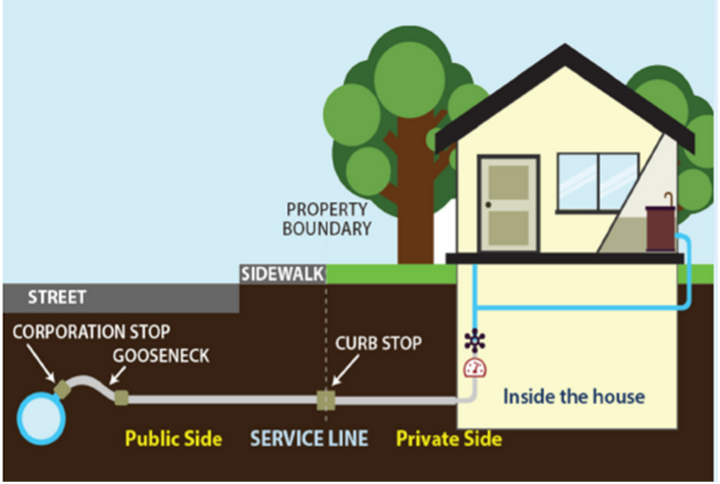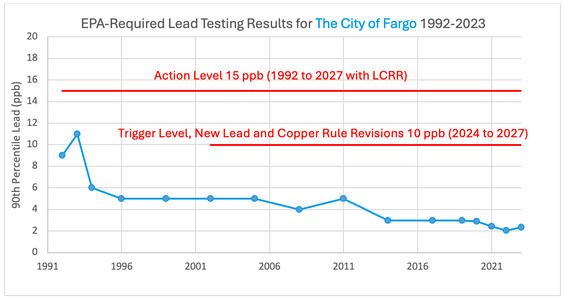Frequently Asked Questions
How does lead get into drinking water?
Fargo’s water sources are the Red River of the North and the Sheyenne River. Water that is treated in the Fargo Water Treatment Plant is thoroughly tested and meets all of the requirements set by the U.S. Environmental Protection Agency (EPA). When water leaves our treatment processes, there is no lead contamination or health risks from exposure to lead.
Lead can enter drinking water when pipes and plumbing fixtures made of lead, or containing a mixture of lead, corrode. Many factors affect the corrosion process, such as water chemistry and the mixture of plumbing materials found in a dwelling. The process of corrosion is likely to occur when the water is acidic and has a low mineral content, leaching lead from the pipe material into the water within the pipe. Learn more about the conditions that can contribute to corrosive water by visiting the EPA website.
Factors affecting the corrosion process:
- Type and amount of minerals in water
- Water acidity and alkalinity
- Amount of lead in pipes and plumbing
- Amount of time water is resting in the pipe
- Presence of protective scales and coatings
- Water temperature
Learn more about certified filters that can reduce lead in drinking water here.

What is a Service Line?
The service line connects the water main to the internal plumbing within a building, conveying water from our water main to your faucet. The City of Fargo maintains the service line from the water main to the curb stop. The curb stop is a valve located within the boulevard or easement, allowing the water to be turned on or off to the dwelling. The property owner maintains the service line from the curb stop into the residence. Service lines can be made of different materials, service lines made of lead can present an elevated risk of lead exposure. View the interactive map to learn what your water service line material is currently classified as.
How does The City of Fargo minimize corrosion?
To improve our water quality, meet regulatory requirements, and protect our community, The City of Fargo has made significant improvements in the way our water is treated. Our water chemistry is controlled by treatment techniques that allow us to maintain precise control over pH, alkalinity, mineral content, and other important parameters that help prevent corrosive water conditions.
The treated water also contains a food grade corrosion inhibitor called phosphate. Phosphate creates a passivating film, or coating, on the inside of lead service lines. This coating forms a barrier between the lead pipes and the water, slowing the rate in which lead can leach from the pipe material. Collectively, the entire process of controlling water quality and maintaining a layer of scale is called corrosion control treatment.

What are the testing requirements for the City?
The number of required sample sites to be tested for under the Lead and Copper Rule Revisions (LCRR) is based on the population that a public water system serves. Under the LCRR, the testing sample sites must have lead service lines if available. Sample sites with lead service lines are selected by the North Dakota Department of Environmental Quality using historical documents, development plans, and visual inspections performed during repairs by the City of Fargo utility department.
The EPA rule requires that 90 percent (90th percentile) of the sampled homes must have lead levels below the action level of 15 parts per billion (ppb). Results at 15 ppb or greater require public notification and further actions for a utility under the Lead and Copper Rule Revisions. The 90th percentile result is the value found at one single sampling address. 90th percentile is not an average of testing results across the water system as a whole, or even sampling sites with lead service lines.
The Lead and Copper Rule Revisions also introduces a trigger level of 10 ppb for lead. Test results at or above 10 ppb, and less than 15 ppb, require additional planning, monitoring, and treatment requirements for a water system. Action level and trigger level exceedances indicate that additional measures need to be taken to optimize a water utility’s corrosion control program to prevent corrosion within pipe materials.
Beginning in 2025, The City of Fargo is required to test 100 sites with lead service lines if available under the new LCRR. Due to past test results far below the LCR action level, the Fargo water system qualified for reduced monitoring in 2023 and is not required to test in 2024. The samples are collected by customers in their own homes after the water has not been used for a minimum of 6 hours. The results displayed below indicate that 90 percent of the homes tested with lead is at, or below the yearly reported lead level in ppb. Fargo Water Treatment Plant personnel maintain strict control over our corrosion control program, ensuring our water chemistry is not causing corrosive water conditions. The following chart demonstrates our commitment to quality drinking water.

What does Lead Status Unknown mean?
The City of Fargo has around 30,000 water service connections, each connection added over decades of development. The Lead Service Line Inventory (LSLI) has been constructed using years of available historical data and visual inspections. However, there may be a gap in the data during some periods of development. An unknown also means a visual inspection may be needed or we are still reviewing historical records. If you have received an Unknown notice and have a service line classified as an unknown, more information is needed for our water utility to make a proper classification.
The City of Fargo is planning to improve our Lead Service Line Inventory. For more information proceed to "Improving our Lead Service Line Inventory" below. Our Lead Service Line Inventory will be evolving over time. If you feel your service line is classified incorrectly, or would like an inspection to verify your service line material, please contact the Water Treatment Plant.
You can investigate your water service line in your home by visiting this website.
What is the City doing to improve its lead service line inventory?
City leadership and The City of Fargo Water Utility Department have opted to proceed with a city-wide water meter replacement project. This project has been moved to the forefront and will occur into 2027. This solution is beneficial in two ways. First, this solution will replace outdated meters with advanced metering infrastructure. Second, installers will be able to document water service line material at every address as the meter is installed.
Older neighborhoods with a higher percentage of Lead or Unknown service lines will be targeted in the first phases of this project. Additional inspections and further review of past infrastructure projects will help us confirm the status of each service line. Combined, these actions will give the City of Fargo a detailed inventory of our service line material.

